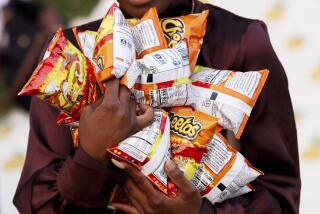Feds funding nature’s candy
Nagging by parents, teachers, doctors and just about every other grown-up hasn’t rid school campuses of junk food. But even fifth-graders agree a new federal program just might help.
The Fresh Fruit and Vegetable Snack Program doesn’t nag. It provides money so that schools can give students the food everyone has been saying they need to eat in order to combat obesity, malnutrition and their attendant ills.
On Thursday, officials showed the program off at Will Rogers Learning Community in Santa Monica, one of 25 California schools participating in it. An additional 180 elementary schools in the state could be funded by the end of the year, said Lorelei DiSogra, a vice president of United Fresh Produce Assn., a Washington, D.C.-based trade group that advocated making the snack program a nationwide effort.
“It has been so significant in such a short amount of time,” said Irma Lyons, the principal at Will Rogers. “You can influence a child’s choices.”
Lori Whitesell agreed. She said that in the first two months of school, her 9-year-old son Tanner has broadened his produce horizons, graduating from eating just celery to broccoli and more. “It’s seeing their peers try things -- maybe someone they admire,” she said.
Thursday was just another snack day at the school, except for the presence of the state agriculture secretary, the Santa Monica schools superintendent and several other local and state officials.
Students from Devon Smith’s fifth-grade class enthusiastically took handfuls of grapes and professed their love for fruits and vegetables. Observers might have concluded that nary a candy bar nor a potato chip had crossed their lips.
“It’s good for your body and your heath,” said one student, Fabian Salinas, who was suspicious but ultimately won over when the class was served golden raspberries. “Everyone has to try new things.”
“Not to brag or anything,” 10-year-old Harrison Saling said, “but I’ve always been pretty good about my fruits.”
“My dad always has fruit, and I definitely got it from him,” he said.
The 2008 federal farm bill expanded the program to all 50 states, providing nearly $49 million for the current school year and growing to $150 million in 2011-12, DiSogra said. California received $2.7 million of this year’s funding, and is expected to receive $8.3 million in 2011-12.
To be eligible, at least half of the students in a school must be eligible for free or reduced-price lunches. The money goes to the states, which distribute it to schools or districts. In the L.A. area, Will Rogers and Edison Language Academy in Santa Monica, Durfee Elementary in Pico Rivera and Columbia Elementary in El Monte were funded.
In return for $50 to $75 per child each year, the schools provide the labor and lessons about the foods. At Will Rogers, parent volunteers wash the produce and deliver it to classrooms for all 560 students each Monday and Thursday, said Pam McRae, the parent in charge.
“The interest here is about trying it, not if you like it or you don’t,” McRae said. But the hope is that kids spread the word to one another and at home.
Schools are free to buy whatever produce they choose, to buy it anywhere they choose, and to hand it out in any manner they choose. In Santa Monica, nearly all the snacks come from farmers markets, said Donna Richwine, nutrition specialist for the district.
Will Rogers already has a salad bar at lunch and a school garden -- two important components of the program, said A.G. Kawamura, secretary of the state Department of Food and Agriculture.
“You introduce new foods through the snack program. And you grow them here on site. When you link that to the nutrition message, you accomplish a more solid lesson,” he said.
The program launched in 2002 at 25 schools in Iowa, Indiana, Michigan and Ohio, as well as the Zuni reservation in New Mexico, said DiSogra, who has worked on the program from the start. She called it “a huge success” and said the U.S. Department of Agriculture will start a formal evaluation next year.
Thursday’s event at Will Rogers came just a day ahead of a major holiday featuring junk food.
But Harrison said that while he’ll indulge, he also will keep things in perspective. “Halloween is just one day,” he said.
--
More to Read
Sign up for Essential California
The most important California stories and recommendations in your inbox every morning.
You may occasionally receive promotional content from the Los Angeles Times.











